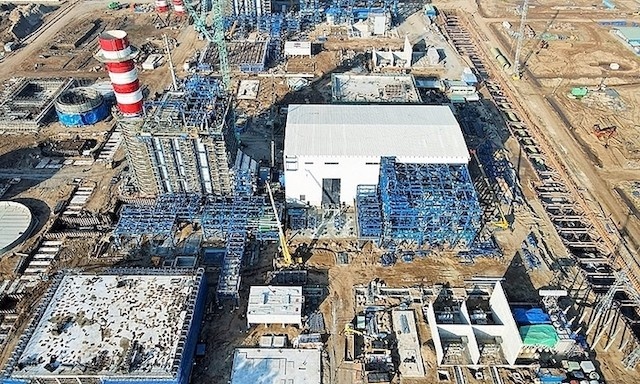Reforms can spur GDP growth
 |
You have stated that the on-year lower GDP growth in this year’s first quarter came as no surprise. Can you elaborate on this?
The National Financial Supervisory Commission has applied some quantitative economic models to study and forecast GDP growth trends. These results show that the economy will continue its upward trend in the long term, but in the short term it will slow from the third quarter of 2015. This was mentioned in our report to the government in late 2015. Therefore, slower GDP growth in this year’s first quarter was foreseen and came as no surprise. The situation was attributed to the following two factors.
First, we have implemented a programme of slashing public investment and tightening fiscal and monetary policies since 2011. The total development investment capital on the GDP ratio has consequently slid from 40-42 per cent to just 30-31 per cent in the past few years. The pace of GDP growth has also slowed down. To offset this capital shortfall, the government has embarked on a comprehensive economic restructuring programme to bolster labour productivity.
Despite reaping initial encouraging results, the higher labour efficiency remains unable to offset the above-mentioned development capital shortfall. The economy continued to rely on the old development model, and if there was growth, it was only temporary. The private economic sector faced a myriad of problems during 2014-2015, so the state sector needed to ramp up efforts to support the aggregate demand. Room for state sector growth, however, has been narrowed and could not be further expanded. In this context, the state budget sources, including government bond capital and that from several state-owned economic sectors, such as oil and gas and mining, have shown signs of stagnation since last year.
Second, exports have managed a fair growth rate over the past few years, mainly driven by foreign direct investment (FDI). When this sector’s exports reached saturation, further growth proved impossible in the short term. The export growth rate this year has also slowed when compared to last year. Also, this first quarter’s GDP growth was affected by a serious drought in the central provinces and salt intrusion in the Mekong Delta region.
What should be done to improve the GDP growth pace?
Slowing GDP growth may continue at least in this year’s first half, possibly even extending to the third quarter. Therefore, it is important to find new motivating forces to boost growth. In the current context, the state sector does not have much room for further growth, so we should rely on the two remaining FDI and private sectors.
The growth perspective of the FDI sector is fairly good, especially when investors are looking to avail of opportunities ushered in by the free trade agreements between Vietnam and other countries, particularly the Trans-Pacific Partnership deal. In addition, international and regional investment flows are undergoing rapid changes. The Chinese economy is decelerating and facing numerous difficulties. This has prompted many foreign investors to shift their investment locations from China to countries such as Vietnam. We can make use of this trend by ramping up efforts to ameliorate the investment climate and enhance competitiveness. The FDI sector, therefore, is in a position to contribute to GDP growth this year and in the upcoming years.
As for the private sector, according to comments from Prime Minister Nguyen Xuan Phuc at a string of recent events, this sector has enormous potential for growth. Introducing consistent and groundbreaking measures to spur private sector growth should become a priority. This will be a key factor and will play a decisive role for the economic rebound taking place from 2016-2020.
How are we to aid the private sector in removing these difficulties, and from there create a new motivating force for growth?
The prime minister has implemented lots of measures which can be categorised into two major groups, related to regulatory reforms and policy management.
Regarding policy, the main attention should be focused on the lending rate issue. Meanwhile, regulatory reforms cover a wide scope and require the application of diverse measures, removing difficulties firms face such as renewing sub-licenses and improving the overall business climate.
What the stars mean:
★ Poor ★ ★ Promising ★★★ Good ★★★★ Very good ★★★★★ Exceptional
Latest News
More News
- Experts give insight into Vietnam's retail sector (April 16, 2024 | 09:00)
- Amendments to gold regulations on agenda (April 12, 2024 | 16:10)
- PV Power secures $300 million loan to fund LNG plants (April 10, 2024 | 17:06)
- Wartsila CEO explores outlook of Vietnam's energy transition (April 10, 2024 | 15:22)
- Driving dual transformation (April 09, 2024 | 17:05)
- Development highlights in Q1 through expert’s lenses (April 08, 2024 | 16:48)
- Vietnam logs 17.1 million business cyberthreats in 2023 (April 08, 2024 | 16:34)
- Vietnam now China's top ASEAN trading partner (April 08, 2024 | 16:26)
- Vietnamese businesses grapple with surging exchange rates (April 08, 2024 | 09:59)
- PM outlines 10 socioeconomic achievements in first quarter (April 04, 2024 | 08:00)

















 Mobile Version
Mobile Version